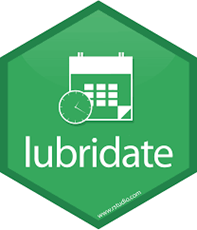18 lubridate

- Link: https://lubridate.tidyverse.org/
- Index of Functions: https://lubridate.tidyverse.org/reference/index.html#section-date-time-parsing
- Cheat Sheet: https://rawgit.com/rstudio/cheatsheets/master/lubridate.pdf
- Chapter of R for Data Science: https://r4ds.had.co.nz/dates-and-times.html
library(lubridate)##
## Attaching package: 'lubridate'## The following object is masked from 'package:base':
##
## datesuppressPackageStartupMessages(
library(dplyr)
)18.0.1 Example Data
Import the example data. This data represents benthic macroinvertebrate data collected in the littoral zone of Onondaga, Otisco, and Cazenovia lakes.
taxa.df <- file.path("data",
"zms_thesis-macro_2017-06-18.csv") %>%
read.csv(stringsAsFactors = FALSE)Preprocess taxa.df to only include unique instances of station IDs and sample dates. For more details about this process see the select and distinct sections.
dates.df <- taxa.df %>%
select(station_id, date) %>%
distinct()
DT::datatable(dates.df, options = list(columnDefs = list(list(className = 'dt-center', targets = 0:2))))18.0.2 mdy, ymd, dmy, ymd_hms, …
- Definition: convert character or numeric data class to a date or datetime class. There are a lot of variations of this function that are specific to the format of your date or datetime.
- Link: https://www.rdocumentation.org/packages/lubridate/versions/1.7.4/topics/ymd
In dates.df, the date column is imported as a character class and follows a “mm/dd/yyyy” format. The function mdy() can be used convert the character strings in the date column to a date class.
mdy.df <- dates.df %>%
mutate(date = mdy(date))
DT::datatable(mdy.df, options = list(columnDefs = list(list(className = 'dt-center', targets = 0:2))))In the example above, it is obvious the the format of the date has changed but it is not obvious that the R-class has changed. First look at the classes represented in the dates.df.
sapply(dates.df, class)## station_id date
## "character" "character"Then looking at the column classes in myd.df, we can see date has changed to class “Date”.
sapply(mdy.df, class)## station_id date
## "character" "Date"18.0.3 year, month, mday, yday, hour, minute, and second
- Definition: these functions allow you to extract a specific feature of a date or datetime class. The returned values will no longer be a date or datetime class.
- Links:
- year: https://lubridate.tidyverse.org/reference/year.html
- month:https://lubridate.tidyverse.org/reference/month.html
- week: https://lubridate.tidyverse.org/reference/week.html
- day: https://lubridate.tidyverse.org/reference/day.html
- wday
- mday
- qday
- yday
- hour: https://lubridate.tidyverse.org/reference/hour.html
- minute: https://lubridate.tidyverse.org/reference/minute.html
- second: https://lubridate.tidyverse.org/reference/second.html
Once a column is a date or datetime class, then lubridate functions make it easy to extract parts of the date, such as year, month, day, hour, minutes, seconds, etc. In the mutate() call below, I applied many but not all of the helpful functions for extracting datetime related information. The majority of these are straight forward; however, we can change label and abbr to alter the output of functions like month() and wday().
labellabel = FALSEreturns a numeric valuelabel = TRUEreturns a character value
abbr- If
label = FALSE, thenabbrhas no effect label = TRUEandabbr = TRUEreturns an abbreviated character string- week: Sun, Mon, Tue, Wed, Thu, Fri, Sat
- month: Jan, Feb, Mar, Apr, May, Jun, Jul, Aug, Sep, Oct, Nov, Dec
label = TRUEandabbr = FALSEreturns an full character string- week: Sunday, Monday, Tuesday, Wednesday, Thursday, Friday, Saturday
- month: January, February, March, April, May, June, July, August, September, October, November, December
- If
extract.df <- mdy.df %>%
mutate(year = year(date),
month_int = month(date),
month_abv = month(date, label = TRUE),
month_full = month(date, label = TRUE, abbr = FALSE),
week = week(date),
day = day(date),
wday_int = wday(date),
wday_abv = wday(date, label = TRUE),
wday_full = wday(date, label = TRUE, abbr = FALSE),
mday = mday(date),
qday = qday(date),
yday = yday(date),
hour = hour(date),
minute = minute(date),
second = second(date))
DT::datatable(extract.df, options = list(scrollX = TRUE))18.0.4 round_date, floor_date, and ceiling_date
- Definition: round a date or datetime value by a specified unit of time.
- Links: https://lubridate.tidyverse.org/reference/round_date.html
round_date() will round the date or datetime by the specified unit of time, such as “15 minutes”, “week”, “month”, or “year”. I find it really convient that you can specify to the nearest “15 minutes”. floor_date() and ceiling_date() provide similar functionality but always round down or up, respectively.
round.df <- mdy.df %>%
mutate(round_week = round_date(date, "week"),
round_month = round_date(date, "month"),
round_year = round_date(date, "year"),
round_year5 = round_date(date, "5 years"),
round_century = round_date(date, "100 years"),
floor_month = floor_date(date, "month"),
floor_year = floor_date(date, "year"),
ceiling_month = ceiling_date(date, "month"),
ceiling_year = ceiling_date(date, "year"))
DT::datatable(round.df, options = list(scrollX = TRUE,
autoWidth = TRUE,
columnDefs = list(list(width = '70px', targets = c(2)))))